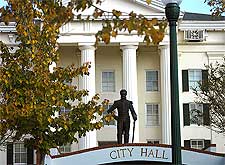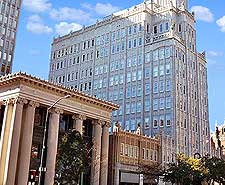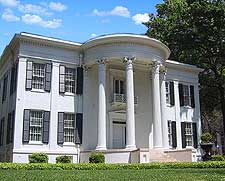Jackson History Facts and Timeline
(Jackson, Mississippi - MS, USA)

The Mississippi capital of Jackson gives the third-most 'bang for your buck' of all US metropolises, according to a well-known consumer magazine.
Known by its municipal authorities as the 'City with Soul', it was named in 1821 after General Andrew Jackson, who later became a US president in 1829. The area was originally owned by the Choctaw Indian Nation.
Early Days
Due to the settlement's trading location on the Natchez Trace trade route, the UK government forced out the Choctaw Nation with the Treaty of Doak's Stand, which was signed in 1820. First named for a French-Canadian fur trader, Louis LeFleur, the area that is now Jackson was surveyed by William Lattimore, Thomas Hinds and James Patton, on the order of the Mississippi General Assembly, as the site of a capital for the state.
Chosen for its central location in the state, the new settlement was enshrined in state law as the capital of Mississippi in 1821 and designed with parks and green spaces interspersing the city blocks, a plan that was unfortunately lost in modern times. One of the first innovations brought in by the state assembly, during this period of Jackson history, was a law to allow married women the previously denied right of owning property.

Development and the Civil War
The railroad linking Jackson with other cities in the state arrived in 1840, although Jackson's development in comparison with other recently formed towns was slow, as the city had no connection with a major river. Despite being a small conurbation by the time the Civil War broke out in 1861, the city soon became a hub serving the Confederate states with manufactured goods.
In 1863, Union forces entered the city after the Battle of Jackson, ejecting the Confederate Army and looting and burning factories, as well as the premises of and rail supply merchants. However, once the Union Army's attention had turned elsewhere, Confederate soldiers crept back in, building defenses against its recapture. Finally, the week-long Siege of Jackson resulted in a Union victory and the destruction by fire of every building left standing after the siege.

Segregation and the Turn of the Century
In late 19th-century Jackson history, more violence broke out as Democratic paramilitary groups began to form, aimed at ousting former slaves from the polls and returning political power to the state's Republican Party. Opposed by the Supreme Court as an unconstitutional measure in the early years of the 20th century, the groups' aims were blocked, but legislators in the region continued to find ways to disenfranchise black residents.

20th-Century Profile
Economic recovery in Jackson's history proceeded at a slow rate, with little real growth until the early 20th century. By 1920, a number of rail lines served the city, and upscale hotels and large commercial office buildings had been constructed, drawing in major companies. The ghettos forming black communities, however, were still in place.
By 1920, oil and natural gas had been discovered in the region, with some 14 rigs dominating the city's skyline by 1930. The revenue stream from the discovery helped shield Jackson from the worst effects of the Great Depression and at the industry's height, well over 100 wells were active. However, supplies soon ran out and most wells were decommissioned by 1955.
Riots and mass demonstrations typified the 1960s as the Civil Rights movement took hold across the US. The killing of civil rights activist Medgar Evers sparked thousands to join his funeral procession in protest, and the violence continued even after the passing of the Civil Rights Act in 1964, with the Ku Klux Klan adding to the brutality in 1967 with the bombing of a synagogue and the home of its rabbi. Recent Jackson history saw the city elect its first African-American mayor in 1997.
 The Mississippi capital of Jackson gives the third-most 'bang for your buck' of all US metropolises, according to a well-known consumer magazine.
The Mississippi capital of Jackson gives the third-most 'bang for your buck' of all US metropolises, according to a well-known consumer magazine.

